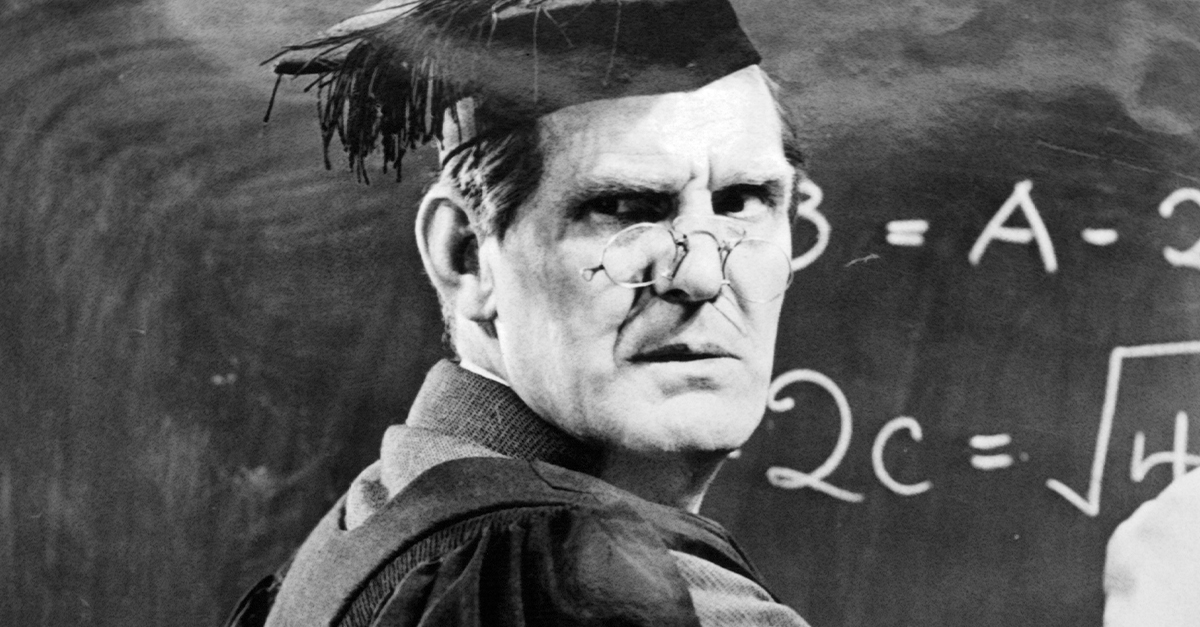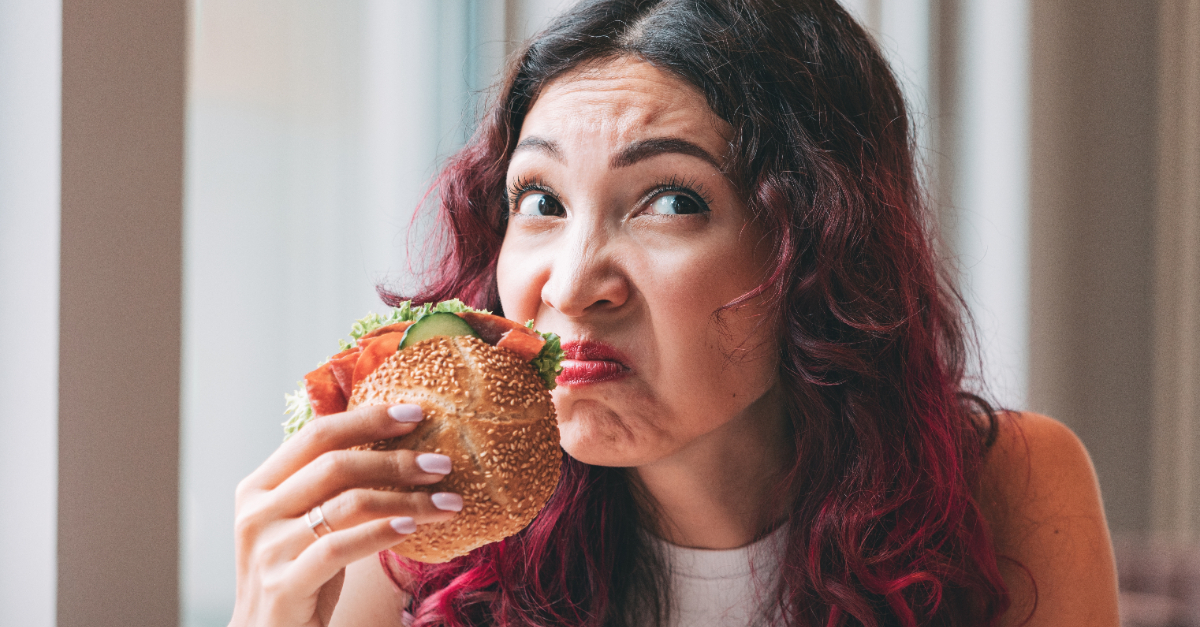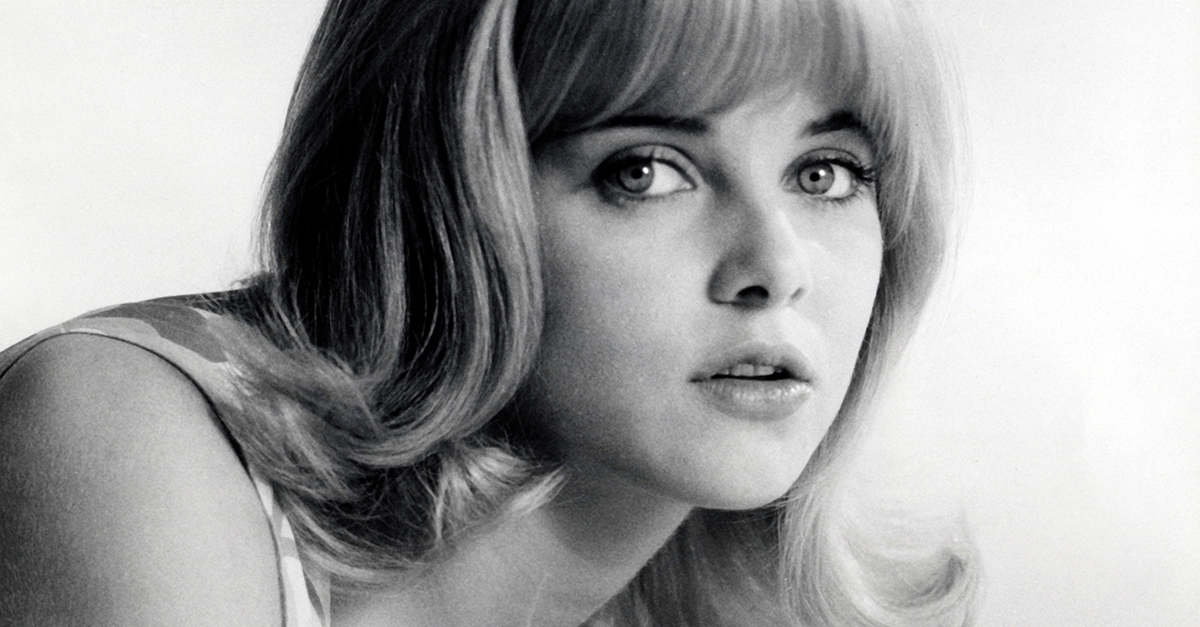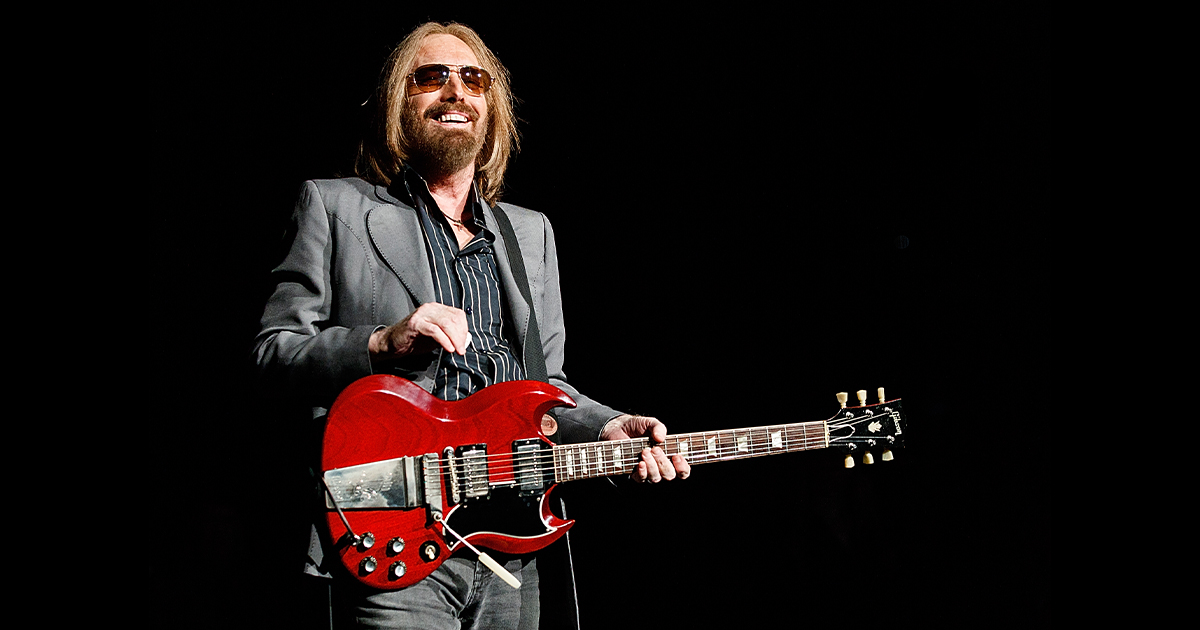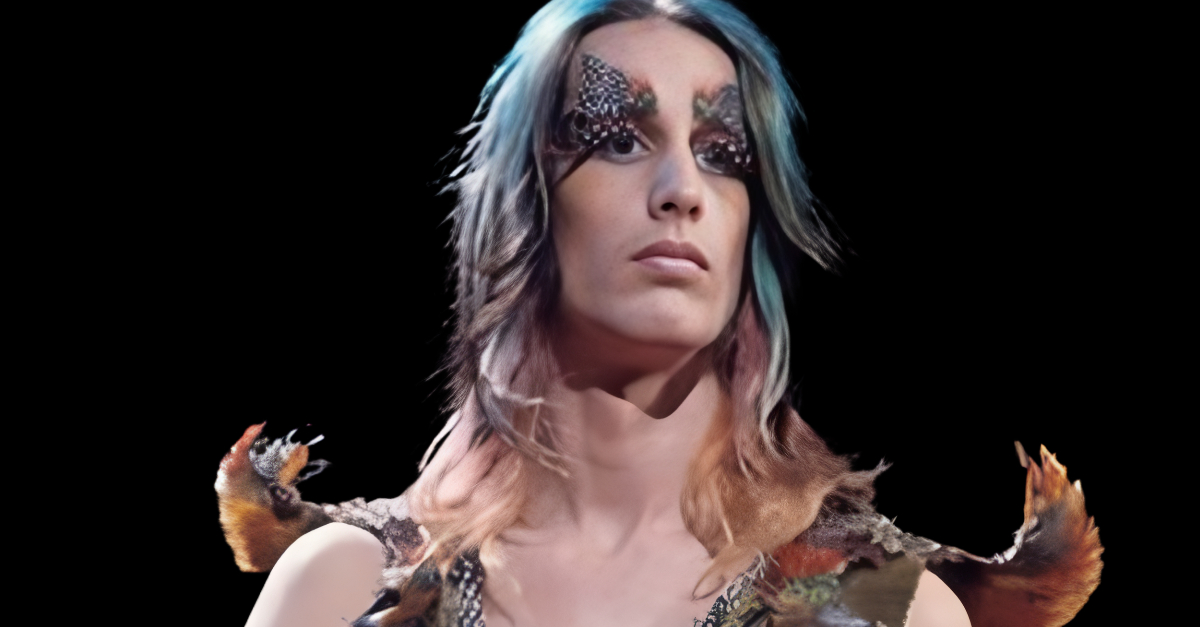A Rock God
In the 1960s and 1970s, no one could profane Eric Clapton, and his sublime guitar skills were worshipped around the world. Yet behind his relentless shredding and stoic stage presence, Clapton was a bleeding heart, trapped not only in cycles of addiction, but also bound to one of rock history’s most notorious love triangles. The trouble is, as you go deeper into Clapton, it only gets darker.

1. His Family Lied To Him
In 1945 in Surrey, England, Eric Clapton was born into a lie. He was told his entire young life that his grandmother and step-grandfather were actually his parents, after his mother Patricia—who he was told was his sister—had him when she was just 16 years old. It was a shaky foundation to start any life, let alone one that would achieve such dizzying levels of fame.
2. He Was Obsessive
Clapton was always diligent to the point of obsession. When he got an acoustic Hoyer guitar for his 13th birthday, he began playing it to distraction, even getting expelled from the Kingston College of Art because he was more interested in music. The teenager would constantly record his practices, then re-listen to them until he got everything just right.
With dedication like this, it wasn’t long before people began to notice.
 RSO Records, Wikimedia Commons
RSO Records, Wikimedia Commons
3. He Joined The Next Big Thing
Clapton loved Blues music as an adolescent, and when he was 18 years old he joined up with the R&B band the Yardbirds, who would soon gain a reputation for churning out famous guitarists. Clapton was no exception: With heroes like Buddy Guy and BB King, Clapton wowed British audiences, especially at the famous Crawdaddy Club in London. It’s also where he got a lasting stage name.
 Chris Hakkens, Wikimedia Commons
Chris Hakkens, Wikimedia Commons
4. He Had Slow Hands
Clapton earned his famous nickname “Slowhand” while with the Yardbirds, which might seem contradictory given his searing guitar playing. The name actually came from Clapton’s tendency to—methodical and diligent as ever—change any broken guitar strings on stage. The audience began doing a slow clap during these moments, leading the Yardbirds’ manager Giorgio Gomelsky to call him “Slowhand”.
Even so, Clapton wasn’t around much longer to bask in the name.
 Stoned59, CC BY 2.0, Wikimedia Commons
Stoned59, CC BY 2.0, Wikimedia Commons
5. He Spurned Fame
Around his 20th birthday, Clapton got one heck of a birthday present: He had his first big hit in the Yardbirds’ “For Your Love”. His reaction stunned his bandmates. While they were all excited by the popularity boost and wanted to create poppier songs, Clapton was loyal to their blues sound and, more than that, disdainful of chasing commercial success. He felt there was only one thing he could do.
6. He Left The Group At A Critical Time
The very day that “For Your Love” went public, Clapton left the Yardbirds—a move he would repeat many times over the years, and which left the band without its lead guitarist. As a testament to just how massive Clapton was as a member, both Jeff Beck and Led Zeppelin’s Jimmy Page took over for guitar in the Yardbirds for a bit after he exited. Clapton, meanwhile, found a way to land on his feet.
 Jim Summaria, CC BY-SA 3.0, Wikimedia Commons
Jim Summaria, CC BY-SA 3.0, Wikimedia Commons
7. A Musician Approached Him
In 1966, after some months of Clapton dipping in and out of bands, drummer Ginger Baker approached him after a show, drove him home, and presented him with a proposition: He wanted to start a band together. Clapton was interested, but he had one condition.
He insisted they take on singer and bass guitarist Jack Bruce as a third. The demand nearly got him killed.
8. He Had A Bad Idea
Ginger Baker knew Jack Bruce a little too well: They had been in a band together already, the Graham Bond Organisation, and they despised each other. They would fight on stage, try to mess with each other’s instruments, and Baker ultimately fired Bruce from the band—only to have him come to shows anyway. It had all culminated with Baker threatening Bruce at knifepoint to never come back, the only gesture that finally worked.
Understandably, then, Baker almost swerved his car off the road at Clapton’s choice. But it was still too good an opportunity to pass down.
9. He Was The Cream Of The Crop
By the summer of 1966, the trio had swallowed their egos to form a band. Of course, they did still name their new band “Cream,” since they felt they were the “cream of the crop” of the British blues scene. To be fair, they weren’t wrong, and Cream’s four albums together contain some of the best “sweet ‘n’ sour rock ‘n’ roll” around, including the Billboard top-5 placing “Sunshine of Your Love” on their sophomore effort Disraeli Gears.
Cream also put Clapton on the map—almost literally.
 Michael Ochs Archives, Getty Images
Michael Ochs Archives, Getty Images
10. He Was God
Where Clapton had only been famous in Britain with the Yardbirds, Cream brought him to American prominence—and to worldwide reverence. Cream created their own psychedelic sound, with Clapton playing his famous acid-drop guitar, The Fool. His early time with the band even inspired the spray-painted slogan “Clapton is God” on a wall in North London, which was turned into a famous photograph with a dog peeing on the graffitied wall.
But god or not, Clapton wasn’t invincible.
11. He Played A Sly Trick On His Bandmates
Cream was practically a supergroup, but they had one strange Achilles’ heel. They were too loud, especially for their own members. Jack Bruce would make the volume levels soar so much that Ginger Baker couldn’t compete—which might have been Bruce’s intention, since he and Baker had never truly patched up their differences. Clapton even stopped playing entirely during one concert, and neither of his bandmates noticed.
Then came the review that shattered Clapton.  Michael Ochs Archives, Getty Images12. One Negative Review Stung Him
Michael Ochs Archives, Getty Images12. One Negative Review Stung Him
Clapton has always been voracious in his search for challenges, and he began to feel that Cream wasn’t providing any beyond an exhausting touring schedule and constant peace-keeping between Bruce and Baker. So when Rolling Stone published a scathing review about Cream calling Clapton a “master of the blues cliche,” it confirmed his worst fears, cut him to the quick, and pushed him to disintegrate the group.
By the time the band played their notoriously lackluster farewell concerts in November 1968, as Baker said, “We knew we were just finishing it off, getting it over with”. But the most tumultuous period of Clapton’s life was about to begin.
 Michael Ochs Archives, Getty Images
Michael Ochs Archives, Getty Images
13. He Was In A Supergroup
After Cream fell apart, Clapton began to earn his reputation for skittering along in different bands. Next up was the short-lived supergroup Blind Faith with Ginger Baker, Traffic musician Steve Winwood, and Family’s Ric Grech. An instant audience draw, the band nonetheless didn’t have enough songs to fill a set, and Clapton disbanded the group so fast that Ginger Baker only found out when he came back from holiday.
The trouble was, it wasn’t just Clapton’s career that was suffering.
 Matt Gibbons, CC BY 2.0, Wikimedia Commons
Matt Gibbons, CC BY 2.0, Wikimedia Commons
14. He Had A Teenaged Girlfriend
In the late 1960s, Clapton was in his mid-20s when he met the 17-year-old Alice Ormsby-Gore, a British aristocrat and girl about town. Like everything Clapton did at the time, he jumped in violently fast. Soon, the teenage Ormsby-Gore was practically living with him, and their relationship was volatile and on–off for the next few years. It was also more and more dangerous.
15. He Fell Into Addiction
Around the time that he began dating Ormsby-Gore, Clapton also began heavily using substances—and he took the teenager right along with him. Deeply infatuated with Clapton even though the guitar god was only mildly interested in her, Ormsby-Gore would often run around trying to score for Clapton and herself…but mostly for Clapton. As she put it, “I thought it helped him not to have to face the full horror, himself, of scoring his own…supply”.
Only, the young girl couldn’t prevent the horrors to come.
16. He Formed Yet Another Band
Clapton and his girlfriend preferred the “nodding off” kind of high, but they thankfully narrowly avoided injecting while using during their time together. This kept Clapton, for a time, alert and able enough to continue with his music, and he soon formed the band Derek and the Dominos, also recruiting Duane Allman of the Allman Brothers Band for their first album.
Like so many of his projects, it wouldn’t last long—but this time, tragedy played a hand.
17. His Idol Passed
During Derek and the Dominos’ recording sessions, Clapton got devastating news. His friend and musical hero Jimi Hendrix had perished from a barbiturate overdose. Clapton, who had just bought Hendrix a left-handed Fender Strat for a birthday present, was shaken, and went through the Dominos’ upcoming tour in a total haze of substances.
Little did he know, another slap in the face was coming.
 Unknown Author, Wikimedia Commons
Unknown Author, Wikimedia Commons
18. He Lost His Friend
Clapton was extremely close to Dominos’ contributor Duane Allman, calling him the “musical brother I’d never had but wished I did”. Yet Allman, too, was ripped away from Clapton. In October of 1971, Allman was riding his Harley Davidson when he got into an accident with a flatbed truck, and soon perished from internal injuries.
The Dominos had one final tragedy to come.
 Michael Ochs Archives, Getty Images
Michael Ochs Archives, Getty Images
19. His Bandmate Was Very Ill
Clapton was living in a lawless rock and roll world, but Derek and the Dominos’ drummer Jim Gordon was something else. Gordon often behaved violently and erratically, once punching his girlfriend Rita Coolidge in a hotel hallway around the time of the Dominos. Worse, while doctors believed it was alcohol issues, Gordon was actually suffering from undiagnosed schizophrenia: He began hearing voices, and took his own mother’s life in 1983.
Clapton, meanwhile, was still circling his own drain.
 Silver Screen Collection, Getty Images
Silver Screen Collection, Getty Images
20. His Addiction Took Over
Derek and the Dominos eventually disbanded, too—with Clapton walking out of a recording session thanks to an ego clash—and the guitarist was left only with his frustration, grief, and still-simering addictions. It got ugly fast. Clapton and his sometime-girlfriend Alice Ormsby-Gore amped up their use and turned into total recluses. Rock bottom came fast.
 Andreasegde, Wikimedia Commons
Andreasegde, Wikimedia Commons
21. He Put On A Pitiful Show
After Derek and the Dominos, Clapton’s cresting addiction forced him into a career hiatus; after all, he was unable to focus on almost anything but the next score. In New York in August of 1971, he did take the stage for the Concert for Bangladesh benefit show—but it was a heartwrenching disaster.
Clapton, still very much using, passed out on stage and had to be shaken awake to finish the performance. Something had to change.
 Cdcoverdude, Wikimedia Commons
Cdcoverdude, Wikimedia Commons
22. His Rockstar Friend Stepped In
By 1973, even Clapton’s veteran partier friends were putting him on notice. That year, Pete Townshend, of the Who fame, pushed Clapton to perform in an ensemble for the “Rainbow Concert” as a way for him to have a real comeback and kick his habit once and for all.
It would take a lot more than that, though, because Clapton’s problems ran so much deeper.
 Heinrich Klaffs, CC BY-SA 2.0, Wikimedia Commons
Heinrich Klaffs, CC BY-SA 2.0, Wikimedia Commons
23. He Was In Love
Clapton’s rockstar lifestyle certainly hadn’t helped his addictions, but underneath the partying was a deeper hurt: Impossible love. In the late 1960s, right around when he met Alice Ormsby-Gore, Clapton had become close with Beatle George Harrison—and had fallen head over heels in love with Harrison’s wife Pattie Boyd.
Clapton, Harrison, and Boyd are still talked about today as a legendary love triangle, but the real story is as bitter as they come.
 Aubrey Hart, Evening Standard, Getty Images
Aubrey Hart, Evening Standard, Getty Images
24. His Life Was A “Farce”
Clapton’s feelings for Pattie tormented and contorted him. In an effort to forget her, he had even (creepily) dated her sister Paula, not to mention his stringing Ormsby-Gore along for years. Painfully enough, he would eventually refer to these “home affairs” as a “galloping farce” compared to his feelings for Pattie.
He nursed these feelings alongside his addictions until 1970—when he sent perhaps the most famous letter of his life.
25. He Wrote A Traitorous Letter
Unable to take it any longer, Clapton sent Boyd a message in 1970, signing it only “E”. Its contents were utterly scandalous. "I am writing this letter to you, with the main purpose of ascertaining your feelings towards a subject well known to both of us," it began."What I wish to ask you is if you still love your husband?"
It was a bomb dropped right in the middle of Clapton’s life—and Boyd’s.
 Evening Standard, Getty Images
Evening Standard, Getty Images
26. She Rejected Him
Boyd, who initially thought Clapton’s near-unsigned letter was from a “weird fan,” didn’t react well to his declaration. Although Boyd and Harrison were going through a rough patch and it was “tempting,” Boyd later admitted, “I couldn’t do it. It just wasn’t right”. She turned down his offer, and Clapton lashed out the only way he knew how—with music.
27. He Put Out A Legendary Song
In the middle of this mess, and before his addictions fully got the better of him, Clapton had the soaring high of his career—and it was all thanks to this anguish. Derek and the Dominos put out “Layla,” a close-to-the-bone anthem for unrequited love that lays all Clapton’s pain on the table. Once more, though, Pattie Boyd’s response left something to be desired.
28. She Still Didn’t Want Him
“Layla” remains one of the great rock and roll bids for a woman’s heart, but it didn’t move Boyd, at least not enough. Clapton had called Boyd “Layla” before—the song is named after the Persian classic The Story of Layla and Majnun, which is about star-crossed lovers—and she was well aware of its message. She was just also deeply scared of it.
Boyd later remembered: "I was so flattered, but I was also so worried that George would work out why Eric had written this song”. But things began to turn around for Clapton—if not for anyone else.
 Beatles member, George Harrison and Patti Boyd in an interview on their wedding by iconic
Beatles member, George Harrison and Patti Boyd in an interview on their wedding by iconic
29. He Got Clean
1974 became a banner year in Clapton’s life: After an intervention from Pete Townshend and Alice Ormsby-Gore’s father, Clapton got relatively clean, and in the coming months and years he would unleash classics like “I Shot the Sherriff” and the album Slowhand.
But that wasn’t all. 1974 was also the year he and Alice ended things for good…and the year Pattie Boyd became a free agent.
 Unknown authorUnknown author, Wikimedia Commons
Unknown authorUnknown author, Wikimedia Commons
30. He Had A Guitar Duel
Pattie Boyd and George Harrison’s marriage had survived Clapton’s pleading, but it didn’t survive much else. Harrison in particular had indulged in a string of infidelities, with Boyd sometimes lashing out at him with her own. By 1974, they were on very rocky ground, and Clapton took the opportunity to put out one more grand, embarrassing gesture. According to actor John Hurt, that year Harrison and Clapton fought for Boyd in a guitar “duel” in Friar Park. As Hurt recalled, “The air was electric. Nobody dare say a word”.
Although Boyd confirms this, Clapton himself waves away its significance. Except, it worked.
31. His Love Left Her Husband
The same year as the guitar duel between the two rock stars, Boyd finally decided to leave Harrison for good. To be fair, Boyd had also just discovered that Harrison had been having an affair with his bandmate Ringo Starr’s wife, an infidelity she called the “final straw”—but Clapton’s display couldn’t have hurt.
It took until 1977 for their divorce to be finalized, and Clapton was right there waiting.
 Michael Webb, Keystone, Getty Images
Michael Webb, Keystone, Getty Images
32. He Got What He Wanted
Soon after the Boyd–Harrison marriage faltered, Clapton invited Boyd to join him on tour. It went well enough that by 1979, the pair were married. Perhaps best of all, George Harrison didn’t even much mind them getting together; he now called Clapton his “husband-in-law”.
It was everything that Clapton had ever wanted…and it turned into a curse.
 Cummings Archives, Getty Images
Cummings Archives, Getty Images
33. He Was Supposed To Be On Top Of The World
At the turn of the 1980s, Clapton—no longer using and with a new wife—looked poised for even more acclaim. But appearances were deceiving. Although Clapton had kicked one habit, he had fallen more and more into heavy drinking. Around Christmas 1981, he called his manager and admitted he was a heavy drinker and needed treatment. Only, it wasn’t so easy.
 Unknown authorUnknown author, Wikimedia Commons
Unknown authorUnknown author, Wikimedia Commons
34. He Didn’t Want To Let Go
On the flight over to his rehab in Minnesota, Clapton downed drink after drink, aghast at the idea that he could never self-soothe with drink again. In his autobiography, Clapton even admitted that the only reason he didn’t take his own life at this time was because “I knew I wouldn’t be able to drink anymore if I was dead”.
When he arrived, “they had to practically carry me into the clinic”. It was an uphill fight.
35. He Relapsed
Clapton has always held fast to his beliefs, and that includes his addictions. Although he managed to release music in the coming years, he left rehab already on the verge of relapsing; he called his 1984 album Money and Cigarettes "because that's all I saw myself having left".
It would take a second stint in 1987 to make him clean for good…and by then, the damage was irreparable.
 Chris Hakkens, Wikimedia Commons
Chris Hakkens, Wikimedia Commons
36. He Treated His Muse Like Dirt
Pattie Boyd is seen as one of the most important muses in rock and roll history, having inspired not only Clapton’s “Layla” and “Wonderful Tonight,” but also Harrison’s “I Need You” and “For You Blue,” among others. But the love triangle’s romantic myth was far darker in reality. As Clapton’s wife, Boyd became just another woman, and Clapton soon exhibited the same wandering eye that afflicted her first husband.
In fact, the story gets so much worse than that.
37. They Tried To Have Children
Boyd had struggled to have children with Harrison, who refused adoption, and she experienced the same issues while trying to have a baby with Clapton. In 1984, they even tried in vitro fertilization in a bid to have a healthy child at last. Tragically, all they got were miscarriages that laid them both low. But nothing excuses Clapton’s next actions.
38. He Had A Love Child
In 1984, in between his rehab stints, Clapton struck up an affair with Yvonne Kelly, although he was married to Boyd and she also had a husband at the time. The result was scandalous. Kelly became pregnant with Clapton’s child, and the baby, a little girl they named Ruth, was born in early 1985, shortly after Boyd began in vitro fertilization.
Yet Clapton didn’t learn his lesson.
 Chris Haakens from Breda, The Netherlands, Wikimedia Commons
Chris Haakens from Breda, The Netherlands, Wikimedia Commons
39. He Made The Same Mistake
Shortly after the birth of his love child, Clapton had another affair, this time with Italian model Lory Del Santo—and once more, his lover got pregnant. Del Santo gave birth to a son named Conor in the summer of 1986, bringing Clapton’s out-of-wedlock children up to two while Boyd was still desperate to get and stay pregnant.
Clapton’s long-awaited “fairy tale” was coming to an end, and it was not a happy one.
 Enrico Samorì from Forlì, Italia, Wikimedia Commons
Enrico Samorì from Forlì, Italia, Wikimedia Commons
40. He Was Horrific To Her
Clapton’s infidelity with Pattie Boyd is a black enough mark, but nothing compares to his worst sins. In 1999, over a decade later, Clapton confessed to beating Boyd during their fights while still in the throes of his alcoholism, and also admitted that he forced her into intimacy while they were married.
Eventually, Boyd mercifully got out of the vicious marriage, and they divorced in 1989. But when fate did come for Clapton, it was crippling.
 Evening Standard, Getty Images
Evening Standard, Getty Images
41. His Baby Boy Met A Terrible End
In 1991, when Clapton’s son Conor was just four, the boy fell out of a high, open window in his mother’s Manhattan apartment and perished. The tragedy shocked the music world and beyond, and Clapton would later write “Tears in Heaven” in memory of his son. But few people know the most heartbreaking part of the tragedy.
 Georges DeKeerle, Getty Images
Georges DeKeerle, Getty Images
42. He Froze At A Critical Time
Clapton was nearby when Del Santo called him screaming about the accident, and actually witnessed his son’s last moments—but he could only do so from afar. After walking from his hotel to the site, he recalled, ”seeing a crowd of people and a paramedic van and knowing that he was there and walking by, I’ll punish myself forever…Why didn’t I go to see him?…the truth is I couldn’t. I was so frightened”.
It was not the last loss Clapton would experience in the 90s.
43. Others Paid For His Sins
In 1995, Clapton’s old girlfriend Alice Ormsby-Gore perished at the age of 42. A ghost from his past, her demise was its own haunting: After spending her last years in and out of rehab and halfway houses, Ormsby-Gore had perished from an overdose, all those decades after helping Clapton score.
 Evening Standard, Getty Images
Evening Standard, Getty Images
44. He Made A Hateful Speech
Clapton’s personal foibles are not the only fraught aspect of the guitar god. In 1976, while on stage, he made an ignominious rant that began with “Do we have any foreigners in the audience tonight? … Well wherever you all are, I think you should all just leave”. He then continued with the phrase “Keep Britain white”.
Although Clapton would later recant this specific speech, he has been known to support right-wing politicians.
45. He Met A Much Younger Woman
Clapton’s later years have been far steadier than his earlier career, and in 1998 he even managed to have a lasting relationship again. When he was 53, Clapton met the 22-year-old administrative assistant Melia McEnery while at a party, and the pair began dating under the radar. Against all odds, they worked.
46. He Started A Family
After decades living as a rock god and battling his various addictions, Clapton finally calmed down and tried to be a good husband. He and McEnery were married in 2002—walking down the aisle in Clapton’s birthplace of Ripley—and they now have three daughters together.
Yet some controversies still follow Clapton around.
47. His Most Famous Song Wasn’t Just His
“Layla” remains one of Clapton’s most famous songs, with the writing credited to Clapton and his bandmate Jim Gordon. Except some say this is an enormous lie. Derek and the Dominos band member Bobby Whitlock claims that Gordon actually stole the piano melody at the end of the song from his ex-girlfriend, musician Rita Coolidge. As Whitlock put it, “Her boyfriend ripped her off”.
But according to Coolidge herself, Clapton was directly involved in the pilfering.
48. He Stole From Another Musician
In 2016, Coolidge set the record straight about “Layla,” and she was scathing. She related how she and Gordon actually met with Clapton to give him a demo of the piece she helped write. That was the last she heard of it—until, that is, she heard her melody on “Layla” coming out of a PA system a year later.
When she tried to contact Clapton to sort it out, she got back an ice cold reply.
49. He Ignored The Truth
Clapton’s manager Robert Stigwood picked up Coolidge’s call, and told her in no uncertain terms: "What are you gonna do? You're a girl. You don't have money to fight this. Let it go”. Although Coolidge believes Clapton is aware of the situation, she has not heard from him once on the matter.
50. He Has A Complex Legacy
Today, Clapton is 80 years old and still a titan of his industry, having introduced countless innovations and inspired countless guitar players in his wake, whether he was playing his Les Pauls or his Strats. Yet beneath the gilded surface of his well-earned icon status lies a complicated and tormented legacy—and a life full of self-destruction, tragedy, and betrayal.
You May Also Like:
Eddie Van Halen Was Straight-Up Unhinged
The Tragic Life Of Pop Queen Connie Francis


























